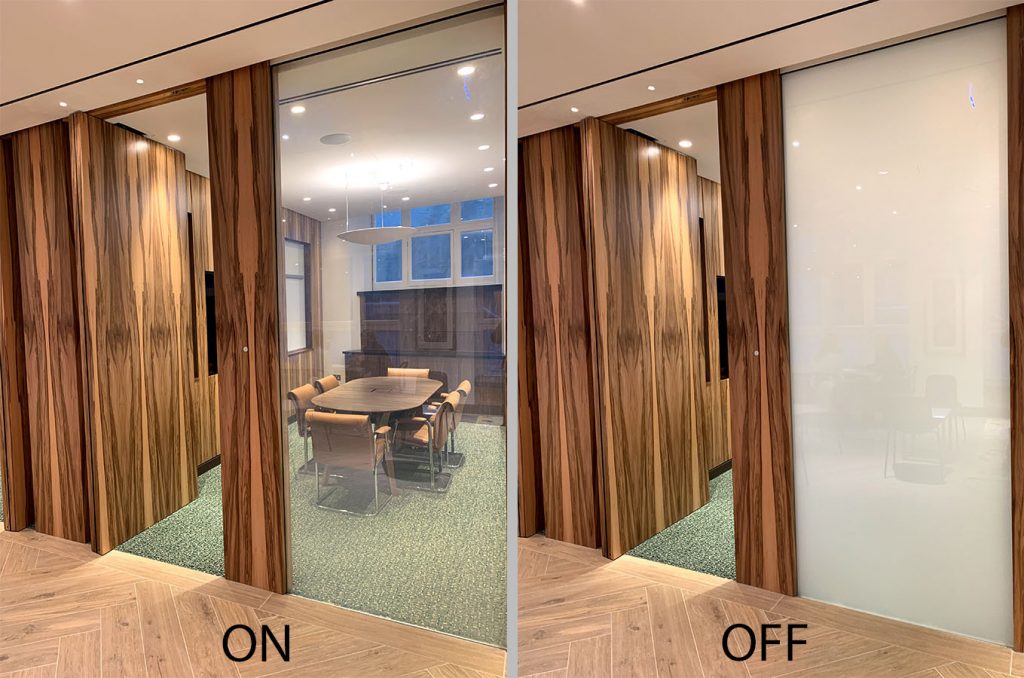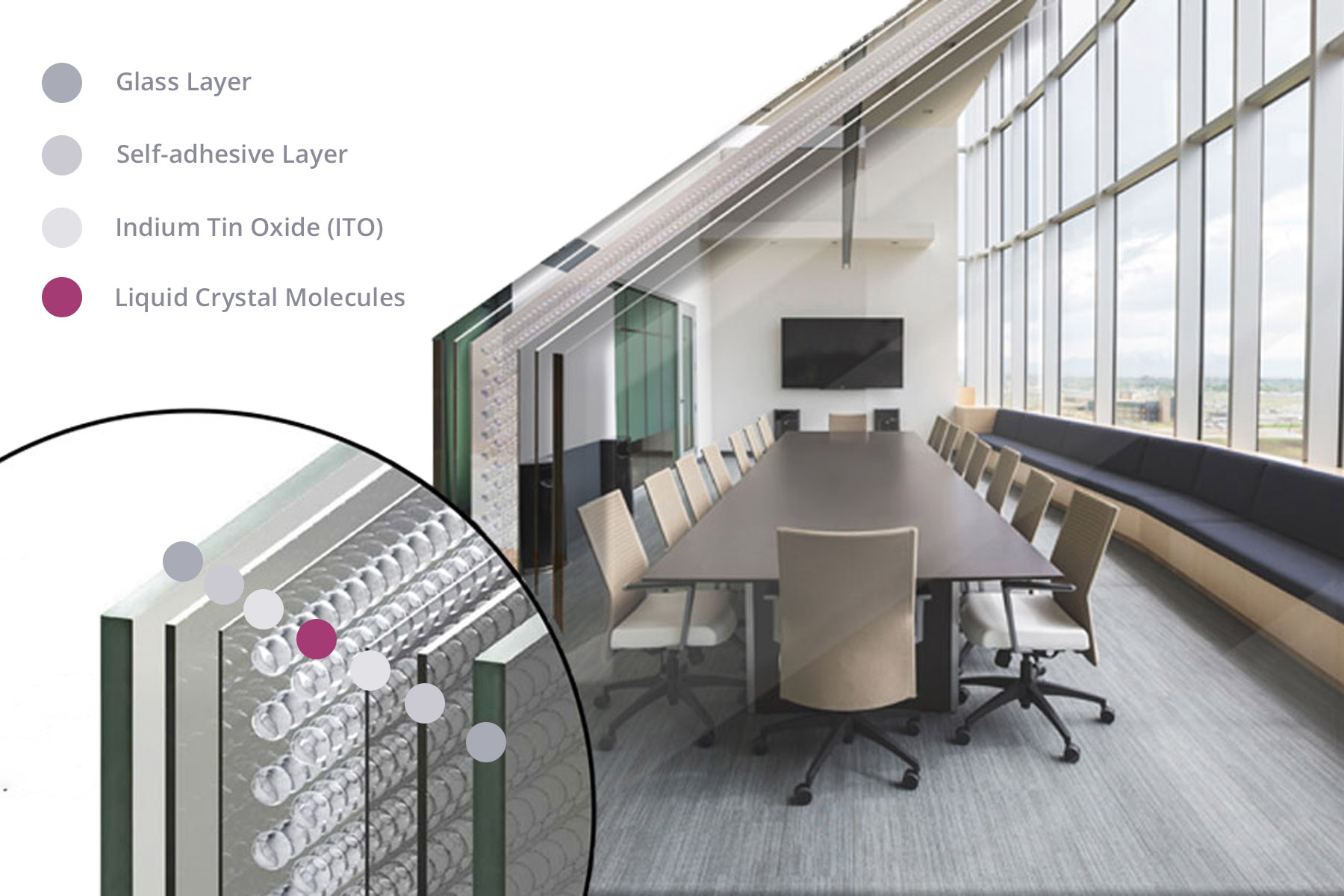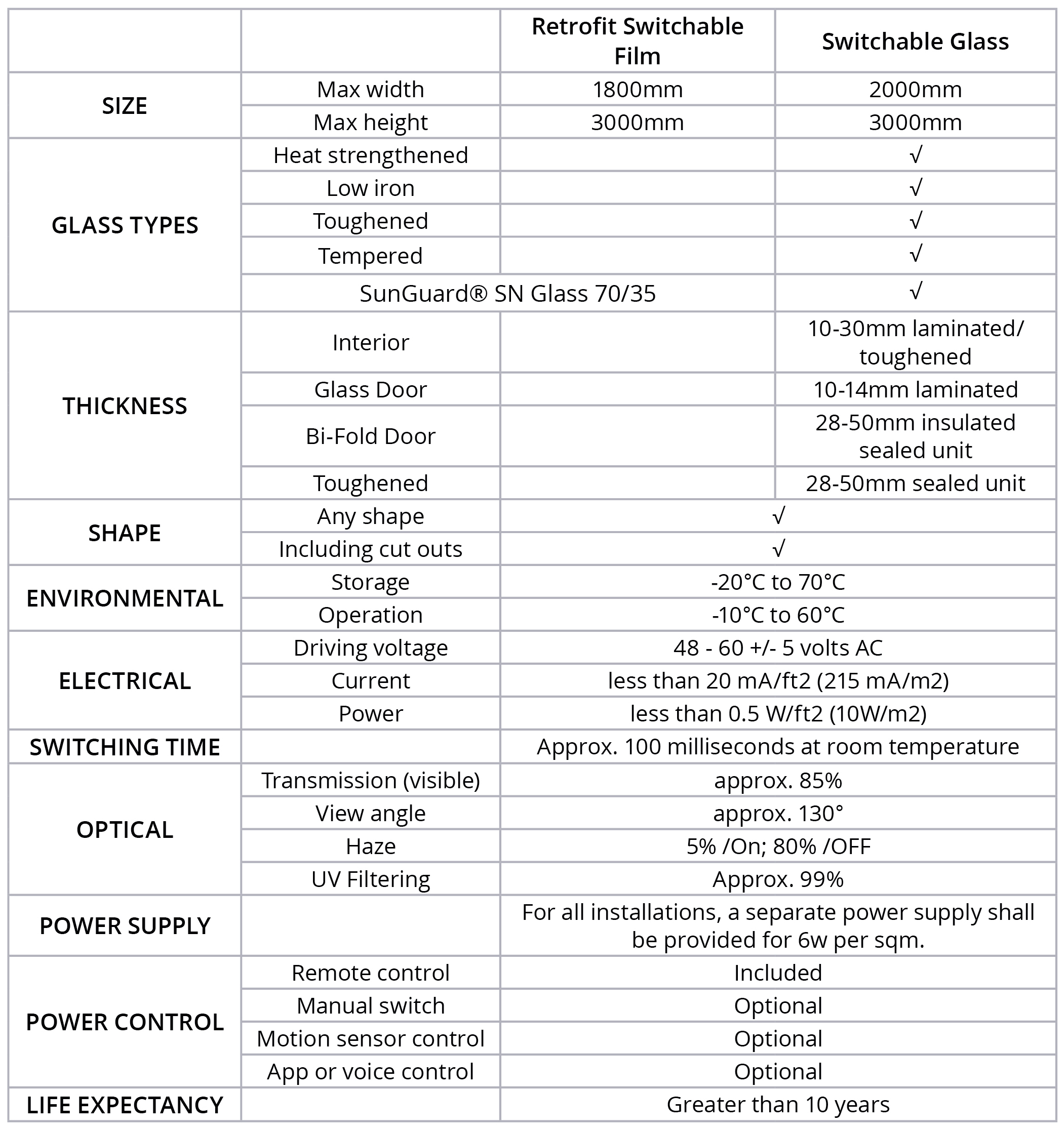Priviglaze Switchable Smart Glass

Utilising state-of-the-art Polymer Dispersed Liquid Crystal (PDLC) technology, Priviglaze Switchable Smart Glass offers innovative solutions for privacy and design. Proudly laminated within the United Kingdom, each Priviglaze unit not only carries the esteemed British Kitemark but is also toughened in accordance with British Safety Glass standards, ensuring a durability that exceeds a decade. The versatility of this product is showcased through its widespread use in various applications such as sealed units, wall partitions, roof lights, and shop fronts.
The core feature of the Priviglaze technology lies in its ability to transform from transparent to opaque at the flick of a switch. This instantaneous switch is powered by the application of an electric current, enabling a clear view or complete privacy as required. In its opaque state, the glass doubles as a high-definition (HD) rear projection screen, adding a layer of functionality. Recognizing the unique needs of each client, Priviglaze offers bespoke solutions. Prospective clients are invited to consult with their team of experts to discover the array of options tailored to individual requirements.
Smart Glass: The Future of Transparency and Privacy
Introduction to Smart Glass
Smart Glass, a revolutionary technology, merges the boundaries between functionality and aesthetics. It’s a dynamic material that changes its light transmission properties under the influence of light, temperature, or electrical voltage. Initially conceptualized for high-end luxury projects, Smart Glass has evolved, becoming more accessible and versatile.
How Smart Glass Works
At the heart of Smart Glass technology lies the clever manipulation of materials like electrochromic, photochromic, thermochromic, and liquid crystal displays. These materials respond to electrical stimuli or environmental changes, altering their transparency. Each type offers unique characteristics, catering to different needs.
Applications of Smart Glass
Smart Glass is not just a product of modern innovation; it’s a versatile solution applied in numerous fields. In architecture, it’s transforming buildings into responsive entities that adapt to environmental conditions. In the automotive industry, Smart Glass is enhancing privacy and comfort, while in consumer electronics, it’s opening new dimensions for device interfaces.

Benefits of Using Smart Glass
The primary advantages of Smart Glass include its contribution to energy efficiency and environmental sustainability. By regulating light and heat transfer, it reduces the need for artificial lighting and climate control. It also offers unmatched privacy and security, a significant upgrade over traditional materials.
Smart Glass in Modern Architecture
Architects are increasingly embracing Smart Glass for its aesthetic appeal and functional benefits. Iconic buildings around the globe showcase its use in creating dynamic façades and interactive interiors. The trend is towards more integrated and sustainable architectural designs.
Priviglaze Smart Glass Technical Data

Smart Glass in the Automotive Sector
In vehicles, Smart Glass is redefining user experience. It offers innovative ways to control light and temperature, contributing to passenger comfort and safety. The automotive industry is keenly exploring its potential for smart windshields and sunroofs.
The Role of Switchable Glass in Sustainability
Privacy Switchable Glass is a key player in the sustainability arena. Its ability to control light and heat not only conserves energy but also significantly reduces a building’s carbon footprint. It’s an essential component of green building design, aligning with global sustainability goals.
Challenges and Limitations
Despite its advantages, Smart Glass faces challenges like high production costs and technological complexities. These factors currently limit its widespread adoption. However, ongoing research is addressing these issues, paving the way for more affordable and advanced solutions.
Smart Glass and User Experience
The interaction between Smart Glass and its users is a critical aspect. Modern control systems allow users to adjust transparency at the touch of a button, offering a seamless experience. However, user adoption is still a challenge, requiring intuitive interfaces and reliable performance.
Innovations in Smart Glass Technology
The future of Smart Glass is bright with continuous innovations. Research is focusing on making it more energy-efficient, cost-effective, and versatile. These advancements promise to open new avenues for its application across various industries.
Smart Glass in Consumer Electronics
In the realm of gadgets and devices, Smart Glass is a game-changer. It’s enhancing the functionality and aesthetics of consumer electronics, offering new ways to interact with our devices. Its integration into screens and displays is just the beginning.
Smart Glass in Healthcare Facilities
In healthcare, Smart Glass offers privacy and comfort for patients, a critical aspect of the healing environment. Its use in hospitals and clinics is growing, demonstrating its versatility beyond conventional sectors.
Smart Glass and Privacy Concerns
While Smart Glass offers enhanced privacy, it also raises security implications. Addressing these concerns is crucial for its acceptance and ethical use. Manufacturers and users alike must be vigilant about its potential privacy impacts.
Economic Impact of Smart Glass
The Smart Glass market is expanding, driven by its diverse applications and potential for innovation. This growth presents significant investment opportunities, with the market poised to experience substantial expansion in the coming years.
Smart Glass and Energy Management
Integrating Smart Glass with smart home systems is revolutionizing energy management. It allows for the optimization of energy usage, contributing to smarter, more efficient homes and buildings.
Regulatory and Legal Aspects
Compliance with standards and regulations is vital for the development and implementation of Smart Glass. As its use grows, so does the need for clear guidelines to ensure safety, efficacy, and environmental responsibility.
“Smart Glass”: In-Depth Analysis
A comprehensive review of Smart Glass reveals its vast potential and the challenges it faces. Expert opinions suggest that while hurdles exist, the future is promising, with endless possibilities for innovation and application.
Conclusion
Switchable Glass stands at the forefront of modern technology, offering a blend of aesthetics, functionality, and sustainability. Its journey from a luxury item to a mainstream material symbolizes the progress of technology and its integration into our daily lives.
FAQs
What is Smart Glass?
Smart Glass or Switchable Glass is a technology that allows glass to change its properties, like opacity, in response to environmental stimuli.
How does Switchable Glass contribute to energy efficiency?
By controlling light and heat transfer, Smart Glass reduces the reliance on artificial climate control and lighting, saving energy.
What are the main applications of Switchable Glass?
Its applications range from modern architecture and automotive design to consumer electronics and healthcare facilities.
Are there any privacy concerns with Switchable Glass?
While it enhances privacy, Smart Glass also poses security challenges that need addressing through responsible use and design.
How does Switchable Glass integrate with other smart technologies?
Smart Glass can be integrated into smart home systems for enhanced energy management and user experience.
What is the future of Switchable Glass technology?
The future of Smart Glass lies in further innovations, making it more affordable, efficient, and versatile for various applications.
Would you like to learn more about our product range?
Our team of specialists are happy to help. Contact us today.
